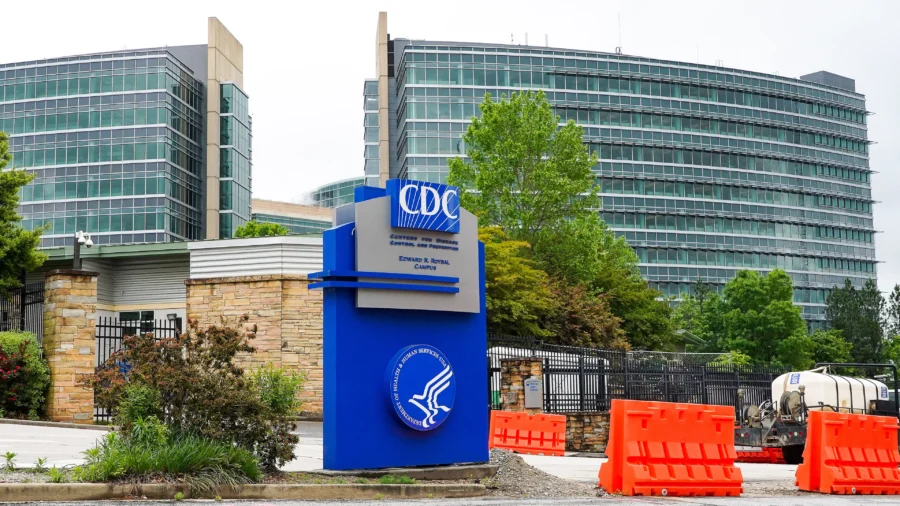The first case of a sexually transmitted skin infection caused by the Trichophyton mentagrophytes type VII (TMVII) fungus has been identified in the United States.
A report published in the JAMA Dermatology journal on June 5 detailed the case of a 30-year-old male who suffered from tinea—a fungal skin infection.
The man, who has a history of sexual relations with other men, had scaly, reddish rashes on his genitalia, arms, legs, and back. He had traveled within California and visited England and Greece before developing the skin lesions.
“He reported multiple male sexual partners while traveling, none with a similar infection, and visited a sauna two months prior to developing skin lesions,” the study said.
The person had no HIV or immunocompromising conditions. He was initially diagnosed with dermatophytosis—an infection of the hair, skin, or nails—and was given medication for a period of four weeks. However, there was no improvement.
Later analysis found that he was infected with TMVII, a sexually transmitted form of the fungal ringworm infection. The patient was given further medications and his condition has since improved.
TMVII has been increasingly reported in Europe. Thirteen cases were identified in France last year, mostly among men who have sex with other males.
The tinea condition explored in the case report “can look very different from the neat, regular circles seen in most forms of ringworm,” according to a June 5 press release from the NYU Grossman School of Medicine.
Hence, they can be confused for lesions caused by eczema, leading to people potentially neglecting the condition for months.
Avrom Caplan, lead author of the study and an assistant professor in the Ronald O. Perelman Department of Dermatology at NYU Grossman School of Medicine, said that health care providers in the United States should be aware that TMVII has now reached the country.
John Zampella, senior author of the study, said that “since patients are often reluctant to discuss genital problems, physicians need to directly ask about rashes around the groin and buttocks, especially for those who are sexually active, have recently traveled abroad, and report itchy areas elsewhere on the body.”
Even though TMVII infections take months to clear up and are difficult to treat, the condition seems to have responded to standard antifungal therapies like terbinafine, he said.
Funding for the study was provided by NYU Langone Health.
The U.S. Centers for Disease Control and Prevention (CDC) referred to TMVII last year in a report, stating that of the 13 cases identified in France, 12 were among men who had sex with other men.
“The study suggests active circulation of the pathogen within this population,” the agency stated.
“Our case series is characterized by a substantial delay in diagnosis. Patients with the most inflammatory lesions were initially mistakenly believed to have had bacterial infections,” the CDC Dispatch from July 2023 said.
“Moreover, prolonged systemic antifungal treatments and patient hospitalizations highlight how severe TMVII infections can be.”
Threat of Fungal Infections
Dr. Caplan published another study in May that looked at a new skin condition that he claims poses a bigger challenge to dermatologists. The study focuses on the Trichophyton indotineae infection that is widespread in India and has now been reported globally, according to the June 5 release.
T. indotineae infections result in contagious and itchy rashes similar to TMVII. However, it usually resists terbinafine treatment. This infection was first confirmed in the United States last year.
Researchers in this study collected laboratory data from 11 men and women treated for ringworm. Their tinea condition was confirmed to have been the result of being infected by T. indotineae.
“Seven of the patients had received standard doses of terbinafine for anywhere from 14 days (the usual duration for most forms of ringworm) to 42 days, yet their rashes did not improve.”
“Analyzing the fungal samples’ DNA, the team reported several variations in the genetic code (mutations) that prevent terbinafine from hooking onto fungal cells and poking holes in their protective membranes.”
This could explain why the treatment failed in some cases.
When seven patients were treated with itraconazole, another antifungal medication, three of them recovered fully while the condition of two people improved.
However, the drug may interfere with other medications and cause side effects like diarrhea and nausea, Mr. Caplan said. This makes it harder for itraconazole to be used in the long term.
Concerns over TMVII and T. indotineae come amid worries about the increase in prevalence of fungal infections. In March last year, the CDC said there was an “increasing threat” of the spread of antimicrobial-resistant fungus in health care centers.
Of particular concern was an emerging fungus called Candida auris, spreading at an “alarming rate” in health care facilities between 2020 and 2021.
The agency found that the number of cases where C. auris infections were resistant to echinocandins, the antifungal medicine usually given for treatment, tripled in 2021.
“In general, C. auris is not a threat to healthy people. People who are very sick, have invasive medical devices, or have long or frequent stays in healthcare facilities are at increased risk for acquiring C. auris,” the agency stated.
“CDC has deemed C. auris as an urgent AR (antimicrobial resistance) threat, because it is often resistant to multiple antifungal drugs, spreads easily in healthcare facilities, and can cause severe infections with high death rates.”
In April 2023, officials confirmed 19 cases of a fungal infection called blastomycosis that were linked to a paper mill in Michigan.
Employees at the factory were subsequently asked to wear N95 masks to curb the spread.
From The Epoch Times

